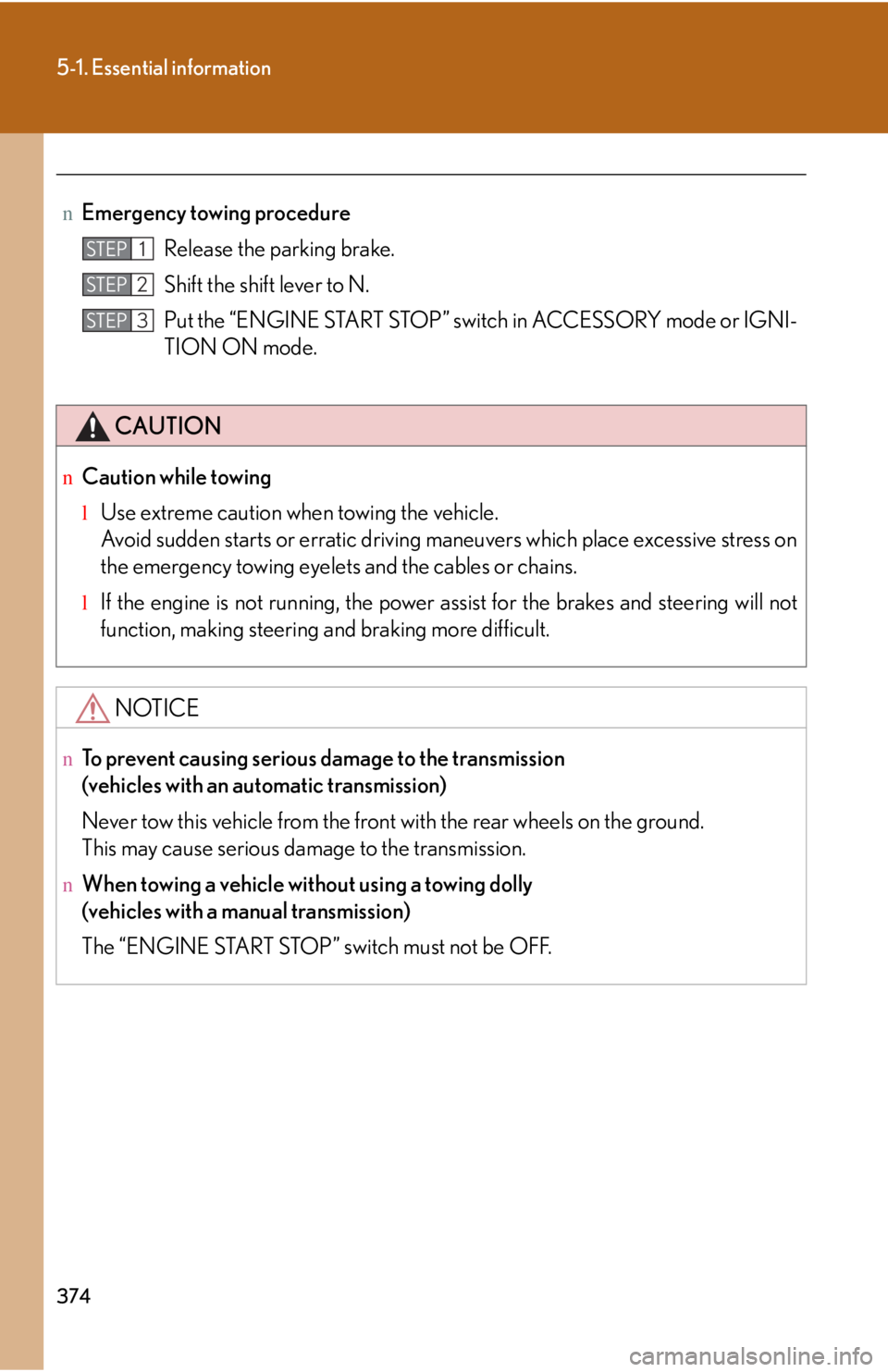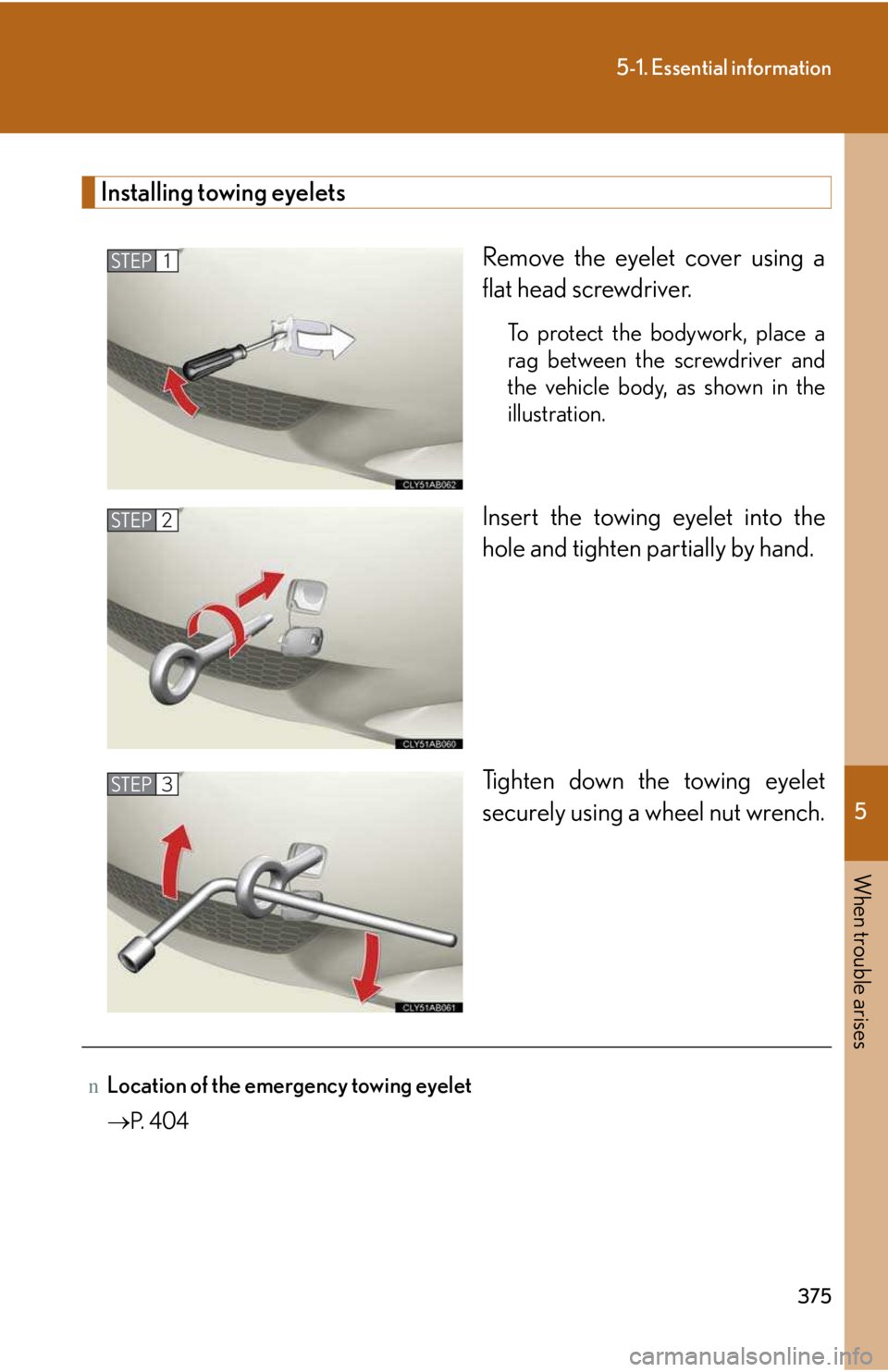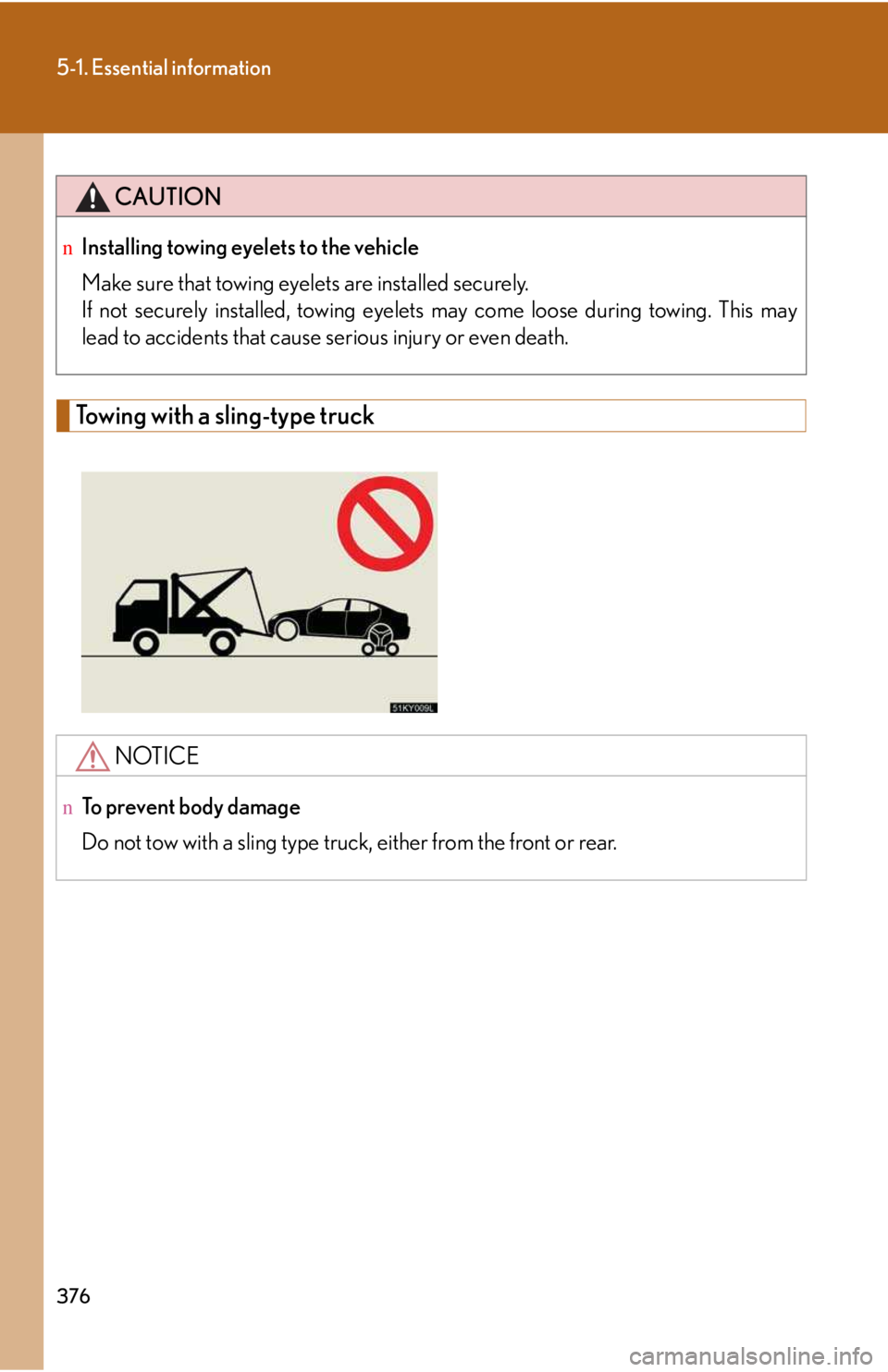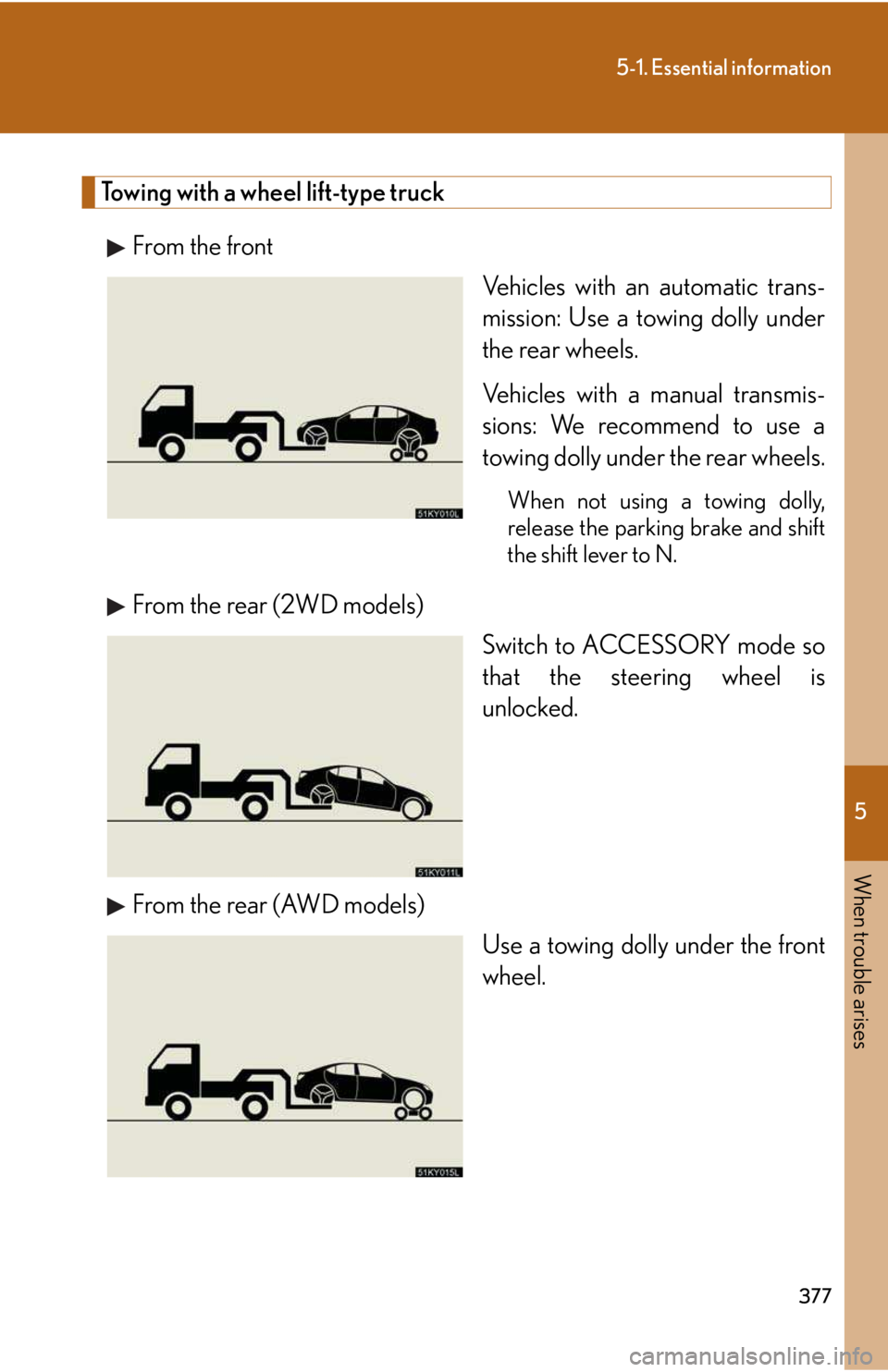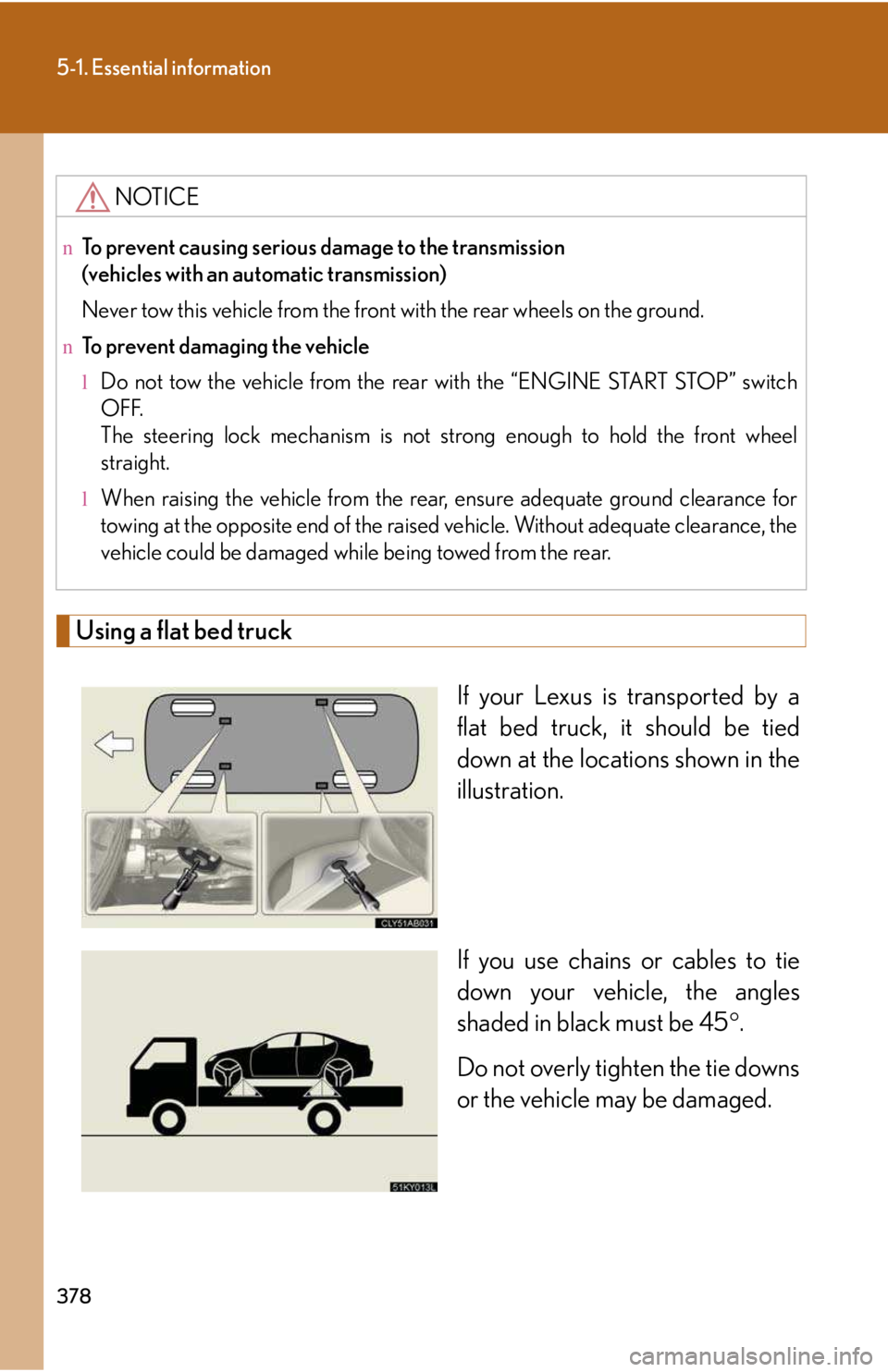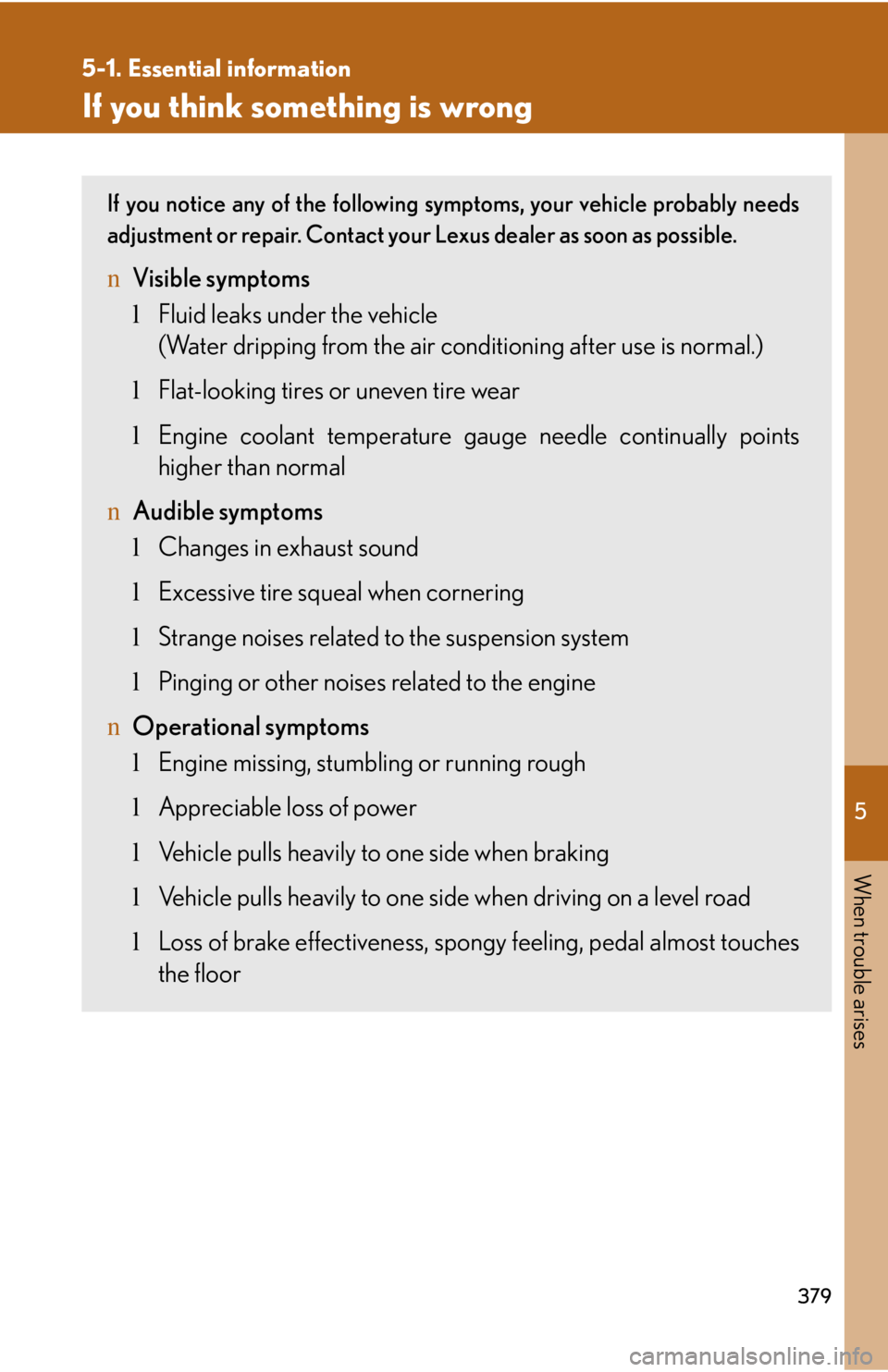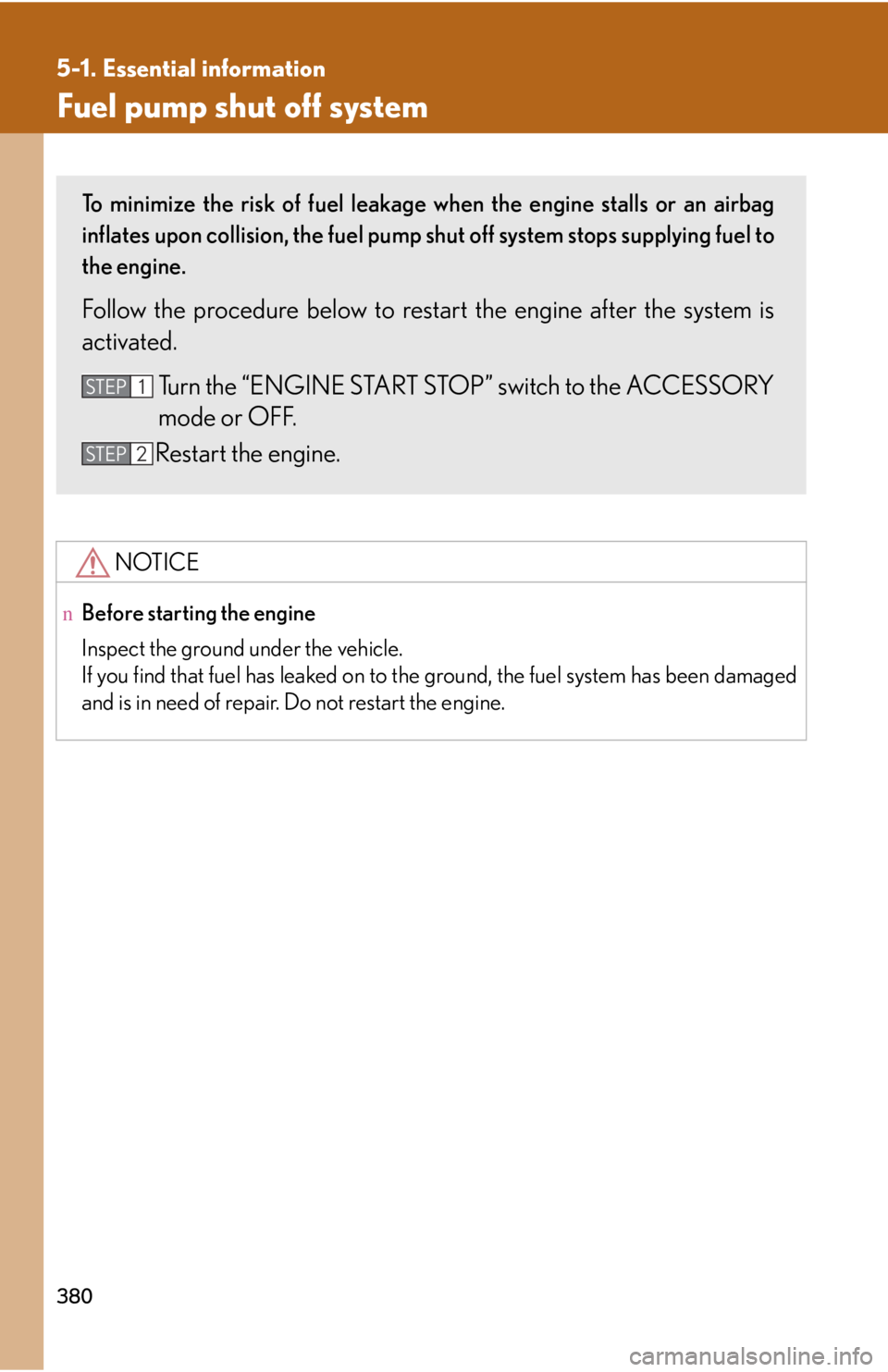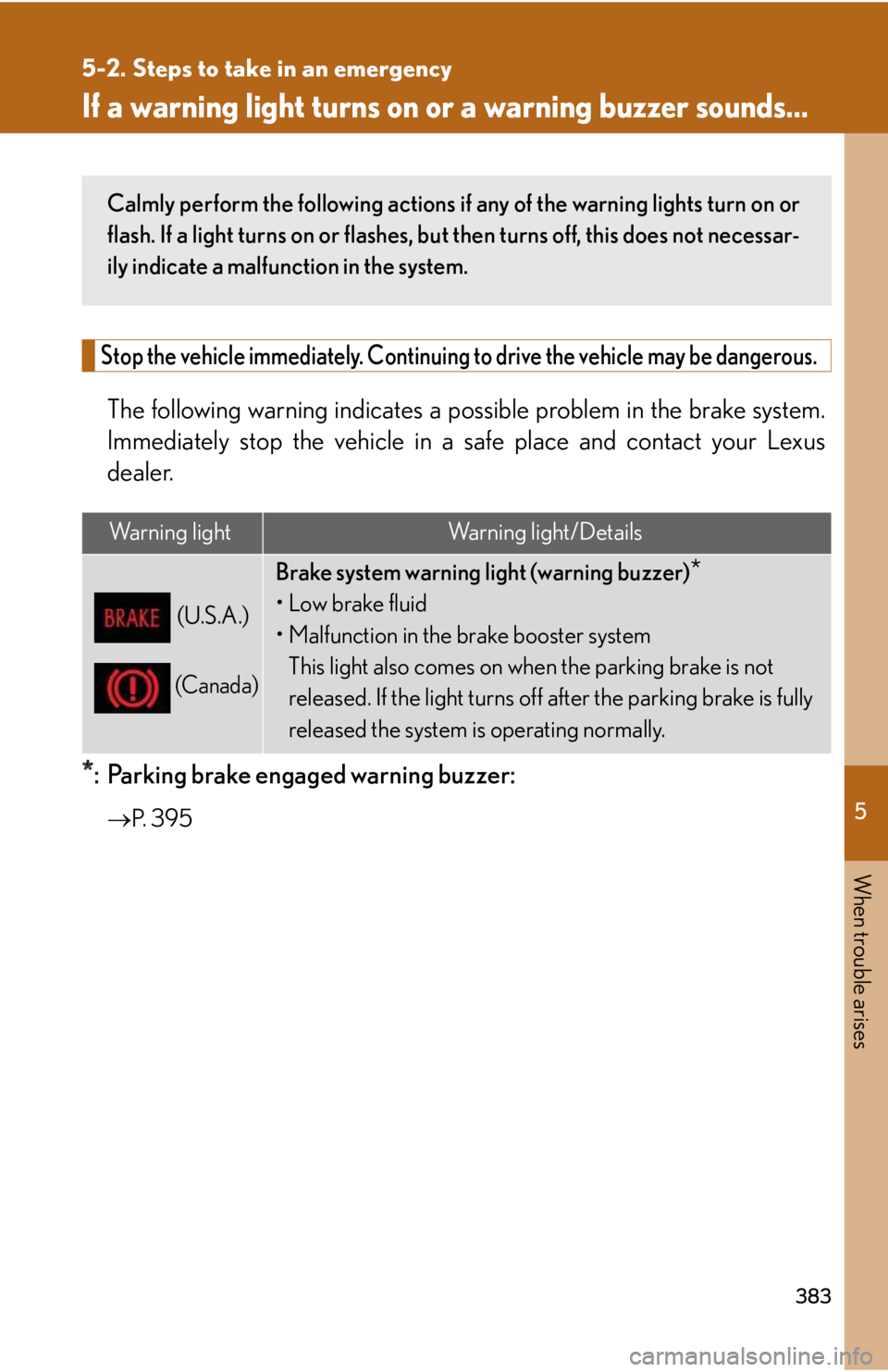LEXUS IS250 2016 Owners Manual
IS250 2016
LEXUS
LEXUS
https://www.carmanualsonline.info/img/36/58921/w960_58921-0.png
LEXUS IS250 2016 Owners Manual
Trending: trailer, glove box, deactivate passenger airbag, check oil, turn signal bulb, fuel, lane assist
Page 371 of 542
374
5-1. Essential information
nEmergency towing procedure
Release the parking brake.
Shift the shift lever to N.
Put the “ENGINE START STOP” switch in ACCESSORY mode or IGNI-
TION ON mode.
CAUTION
nCaution while towing
lUse extreme caution when towing the vehicle.
Avoid sudden starts or erratic driving maneuvers which place excessive stress on
the emergency towing eyelets and the cables or chains.
lIf the engine is not running, the power assist for the brakes and steering will not
function, making steering and braking more difficult.
NOTICE
nTo prevent causing serious damage to the transmission
(vehicles with an automatic transmission)
Never tow this vehicle from the front with the rear wheels on the ground.
This may cause serious damage to the transmission.
nWhen towing a vehicle without using a towing dolly
(vehicles with a manual transmission)
The “ENGINE START STOP” switch must not be OFF.
STEP1
STEP2
STEP3
Page 372 of 542
5
When trouble arises
375
5-1. Essential information
Installing towing eyelets
Remove the eyelet cover using a
flat head screwdriver.
To protect the bodywork, place a
rag between the screwdriver and
the vehicle body, as shown in the
illustration.
Insert the towing eyelet into the
hole and tighten partially by hand.
Tighten down the towing eyelet
securely using a wheel nut wrench.
STEP1
STEP2
STEP3
nLocation of the emergency towing eyelet
�→P. 40 4
Page 373 of 542
376
5-1. Essential information
Towing with a sling-type truck
CAUTION
nInstalling towing eyelets to the vehicle
Make sure that towing eyelets are installed securely.
If not securely installed, towing eyelets may come loose during towing. This may
lead to accidents that cause serious injury or even death.
NOTICE
nTo prevent body damage
Do not tow with a sling type truck, either from the front or rear.
Page 374 of 542
5
When trouble arises
377
5-1. Essential information
Towing with a wheel lift-type truck
From the front
Vehicles with an automatic trans-
mission: Use a towing dolly under
the rear wheels.
Vehicles with a manual transmis-
sions: We recommend to use a
towing dolly under the rear wheels.
When not using a towing dolly,
release the parking brake and shift
the shift lever to N.
From the rear (2WD models)
Switch to ACCESSORY mode so
that the steering wheel is
unlocked.
From the rear (AWD models)
Use a towing dolly under the front
wheel.
Page 375 of 542
378
5-1. Essential information
Using a flat bed truck
If your Lexus is transported by a
flat bed truck, it should be tied
down at the locations shown in the
illustration.
If you use chains or cables to tie
down your vehicle, the angles
shaded in black must be 45�°.
Do not overly tighten the tie downs
or the vehicle may be damaged.
NOTICE
nTo prevent causing serious damage to the transmission
(vehicles with an automatic transmission)
Never tow this vehicle from the front with the rear wheels on the ground.
nTo prevent damaging the vehicle
lDo not tow the vehicle from the rear with the “ENGINE START STOP” switch
OFF.
The steering lock mechanism is not strong enough to hold the front wheel
straight.
lWhen raising the vehicle from the rear, ensure adequate ground clearance for
towing at the opposite end of the raised vehicle. Without adequate clearance, the
vehicle could be damaged while being towed from the rear.
Page 376 of 542
5
When trouble arises
379
5-1. Essential information
If you think something is wrong
If you notice any of the following symptoms, your vehicle probably needs
adjustment or repair. Contact your Lexus dealer as soon as possible.
nVisible symptoms
lFluid leaks under the vehicle
(Water dripping from the air conditioning after use is normal.)
lFlat-looking tires or uneven tire wear
lEngine coolant temperature gauge needle continually points
higher than normal
nAudible symptoms
lChanges in exhaust sound
lExcessive tire squeal when cornering
lStrange noises related to the suspension system
lPinging or other noises related to the engine
nOperational symptoms
lEngine missing, stumbling or running rough
lAppreciable loss of power
lVehicle pulls heavily to one side when braking
lVehicle pulls heavily to one side when driving on a level road
lLoss of brake effectiveness, spongy feeling, pedal almost touches
the floor
Page 377 of 542
380
5-1. Essential information
Fuel pump shut off system
NOTICE
nBefore starting the engine
Inspect the ground under the vehicle.
If you find that fuel has leaked on to the ground, the fuel system has been damaged
and is in need of repair. Do not restart the engine.
To minimize the risk of fuel leakage when the engine stalls or an airbag
inflates upon collision, the fuel pump shut off system stops supplying fuel to
the engine.
Follow the procedure below to restart the engine after the system is
activated.
Turn the “ENGINE START STOP” switch to the ACCESSORY
mode or OFF.
Restart the engine.
STEP1
STEP2
Page 378 of 542
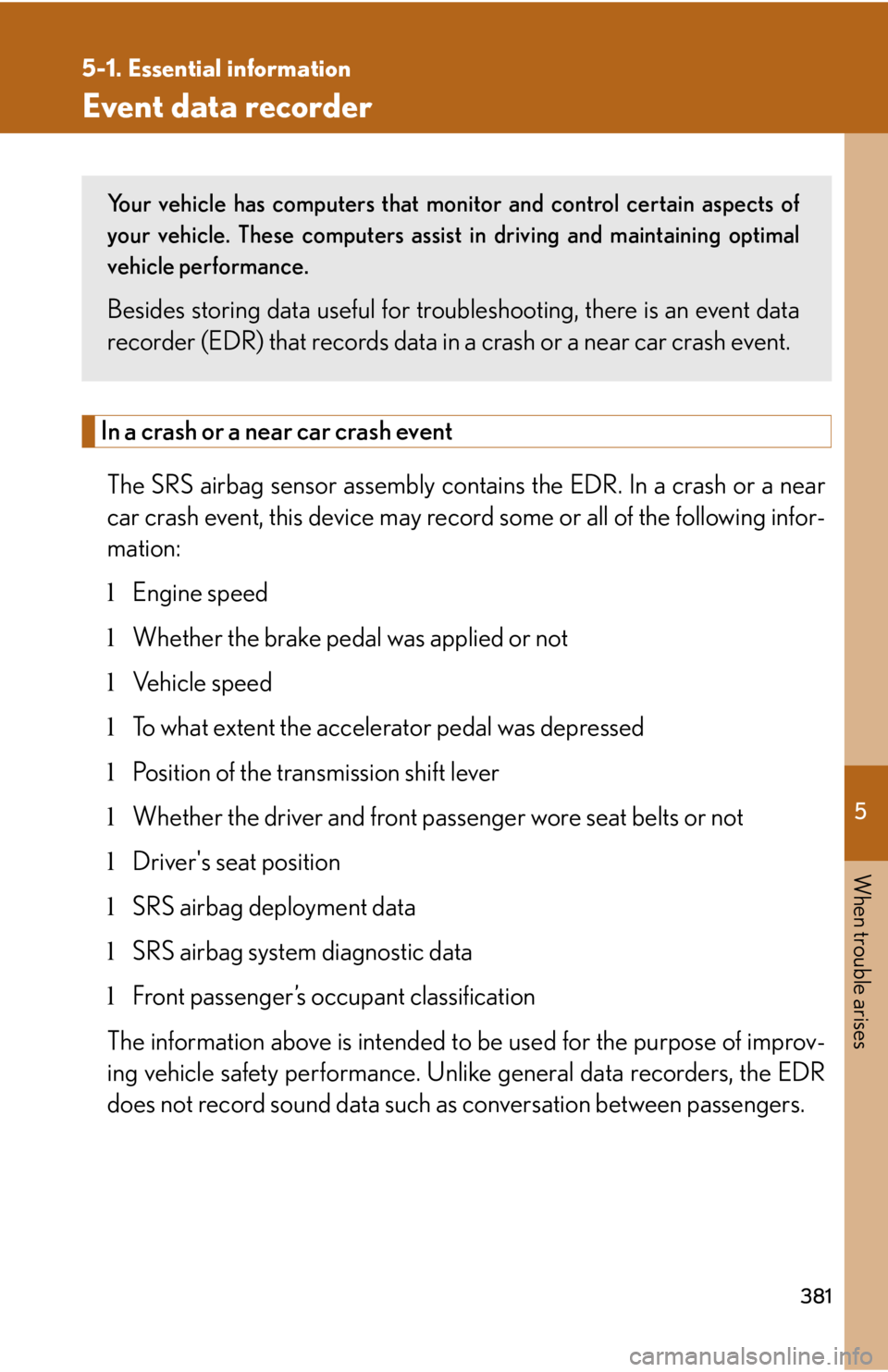
5
When trouble arises
381
5-1. Essential information
Event data recorder
In a crash or a near car crash event
The SRS airbag sensor assembly contains the EDR. In a crash or a near
car crash event, this device may record some or all of the following infor-
mation:
lEngine speed
lWhether the brake pedal was applied or not
lVehicle speed
lTo what extent the accelerator pedal was depressed
lPosition of the transmission shift lever
lWhether the driver and front passenger wore seat belts or not
lDriver's seat position
lSRS airbag deployment data
lSRS airbag system diagnostic data
lFront passenger’s occupant classification
The information above is intended to be used for the purpose of improv-
ing vehicle safety performance. Unlike general data recorders, the EDR
does not record sound data such as conversation between passengers.
Your vehicle has computers that monitor and control certain aspects of
your vehicle. These computers assist in driving and maintaining optimal
vehicle performance.
Besides storing data useful for troubleshooting, there is an event data
recorder (EDR) that records data in a crash or a near car crash event.
Page 379 of 542
382
5-1. Essential information
Disclosure of the data
Lexus will not disclose the data recorded in an EDR to a third party
except when:
lAn agreement from the vehicle's owner (or the leasing company for a
leased vehicle) is obtained
lOfficially requested by the police or other authorities
lUsed as a defense for Lexus in a law suit
lOrdered by a court law
However, if necessary Lexus will:
lUse the data for research on Lexus vehicle safety performance
lDisclose the data to a third party for research purposes without dis-
closing details of the vehicle owner, and only when it is deemed neces-
sary
lDisclose summarized data cleared of vehicle identification information
to a non-Lexus organization for research purposes
Page 380 of 542
5
When trouble arises
383
5-2. Steps to take in an emergency
If a warning light turns on or a warning buzzer sounds...
Stop the vehicle immediately. Continuing to drive the vehicle may be dangerous.
The following warning indicates a possible problem in the brake system.
Immediately stop the vehicle in a safe place and contact your Lexus
dealer.
*: Parking brake engaged warning buzzer:
�→P. 39 5
Warning lightWarning light/Details
(U.S.A.)
(Canada)
Brake system warning light (warning buzzer)*
Trending: key battery, check transmission fluid, towing capacity, coolant, ECU, heater, fog light
